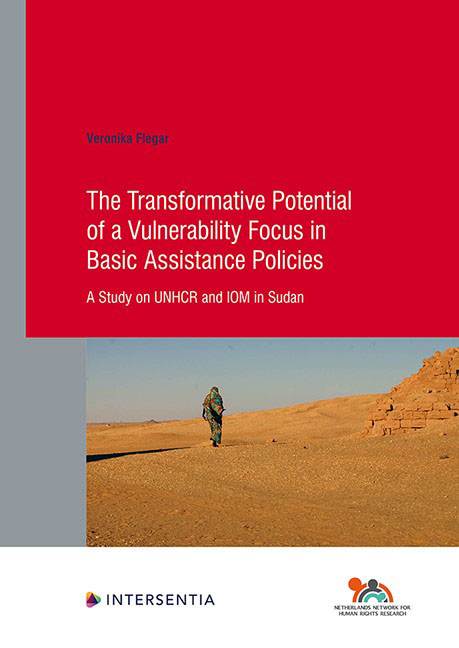 The Transformative Potential of a Vulnerability Focus in Basic Assistance Policies
The Transformative Potential of a Vulnerability Focus in Basic Assistance Policies Book contents
- Frontmatter
- Dedication
- Preface and Acknowledgements
- Contents
- List of Abbreviations
- List of Tables
- List of Figures
- Chapter 1 Introduction
- PART I NORMATIVE AND EMPIRICAL THEORY
- PART II BACKGROUND TO THE CASE STUDIES
- PART III CASE 1: ASSESSING AND ADDRESSING VULNERABILITY AT UNHCR KHARTOUM
- PART IV CASE 2: ASSESSING AND ADDRESSING VULNERABILITY AT IOM KHARTOUM
- PART V
- Bibliography
- Samenvatting
- Summary
- About the Author
- Human Rights Research Series
Chapter 9 - The Transformative Potential of a Vulnerability Focus in Case Study 1
Published online by Cambridge University Press: 11 November 2021
- Frontmatter
- Dedication
- Preface and Acknowledgements
- Contents
- List of Abbreviations
- List of Tables
- List of Figures
- Chapter 1 Introduction
- PART I NORMATIVE AND EMPIRICAL THEORY
- PART II BACKGROUND TO THE CASE STUDIES
- PART III CASE 1: ASSESSING AND ADDRESSING VULNERABILITY AT UNHCR KHARTOUM
- PART IV CASE 2: ASSESSING AND ADDRESSING VULNERABILITY AT IOM KHARTOUM
- PART V
- Bibliography
- Samenvatting
- Summary
- About the Author
- Human Rights Research Series
Summary
The previous chapters (Chapters 6–8) presented the case study's findings regarding the design and implementation of the vulnerability assessment for basic assistance at UNHCR Khartoum. This chapter reviews these findings in light of the two normativetheoretical dimensions of the vulnerability notion's transformative potential outlined in Chapter 2. The discussion focuses on the findings in light of the framework outlined in Chapters 2 and 3 without making extensive use of other possibly relevant literature. This choice was made in order to stay focused on this study's main research interest in the normative evaluation of the policy practice and in understanding the practical feasibility of what is viewed as normatively desirable.
The chapter first reflects upon the transformative potential of the vulnerability focus in UNHCR Khartoum's basic assistance policy for mitigating stigmatisation and stereotyping (9.1). The chapter then evaluates the case study's transformative potential for facilitating socio-economic participation (9.2). Subsequently, the chapter places this analysis in the broader context of the contextual constraints that appear relevant for what is deemed feasible in the design and implementation of the assessment at UNHCR Khartoum (9.3). This is followed by a short summary in the form of concluding remarks (9.4). The chapter does not discuss all findings presented in the previous chapter but limits itself to those that appear most relevant for answering the present study's main research question. Interview quotes from the previous two chapters are sometimes used as examples to illustrate a certain point.
Before embarking upon this discussion, a few general limitations of this case study should be remembered. First, the number of respondents was limited to the persons involved in the specific assessment under investigation. This means that the respondents’ individual opinions weigh heavily in the analysis, especially where the design of the vulnerability assessment is concerned. Moreover, some respondents were more committed to contributing to the research than others which means that their replies are sometimes more prominently reflected in the findings. Yet, the findings are insightful since I interviewed the persons that were most directly involved in the design and implementation of the vulnerability assessment and the number of respondents is therefore thought to have been sufficient to achieve saturation.
- Type
- Chapter
- Information
- The Transformative Potential of a Vulnerability Focus in Basic Assistance PoliciesA Study on UNHCR and IOM in Sudan, pp. 237 - 264Publisher: IntersentiaPrint publication year: 2020
